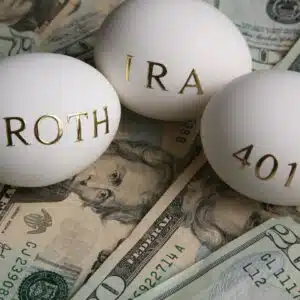Should you have a Roth IRA or 401(k) plan? I like both plans, but for different reasons. That’s because the two plans are very different from one another.
For this reason, you should try to have both plans going at the same time, if it’s possible for you to do that. Each meets a different need, and it’s even possible you could fold one into the other at a later date.
Let’s talk about the two plans, the Roth IRA in the 401(k), and discuss the benefits of each, as well as the important differences.
The Roth IRA – How It Works and How It Helps
Table of Contents
Roth IRA Benefits
Tax-Free Distributions
The main advantage of the Roth IRA is the fact you can take distributions from the plan in retirement that will be completely tax-free. That’s very different from other tax-sheltered retirement plans, such as traditional IRAs and 401(k) plans, which are only tax-deferred.
This is a major distinction. With most retirement plans, the tax benefits are entirely on the front end. But once you retire, and begin taking distributions, those withdrawals will have to be added to your income, and taxed at ordinary income tax rates.
Distributions Won’t Count Toward Your Social Security Taxability
Since the distributions from a Roth IRA are not taxable, they will not count toward your income in determining the percentage of your Social Security income that will be taxable.
No RMD Requirement
Roth IRA plans are not subject to IRS required minimum distribution (RMD) rules.
Those rules require you begin taking distributions from a retirement plan beginning at age 73. You are required to withdraw a percentage of the plan that is based on your remaining life expectancy in each year you are retired, after reaching that age.
But Roth IRAs are not subject to RMD requirements so you can quite literally allow your plan to continue growing for the rest of your life. This has two major advantages:
- It allows you to maximize the amount of money you will have available in your estate in order to pass on to your heirs, and
- It dramatically lowers the possibility you might outlive your money.
The second point is a major issue with most retirees. Since people are now routinely living into their 80s and 90s, the possibility of outliving your money is a real concern. RMDs force you to draw down on your retirement assets.
But you can leave the money in your Roth IRA until the later years in your life when other assets have been depleted. In that way, a Roth IRA can function as an excellent late-retirement income source.
Self-Directed Investing
As is the case with any IRA, you can choose both the plan trustee and the investments held within your account. That gives you complete freedom to choose the investment platform which works best for you, and then to develop your own portfolio allocations.
You can choose to invest in stocks, bonds, mutual funds, exchange traded funds (ETFs), real estate investment trusts (REITS), futures and options, and even managed accounts, like robo-advisors.
Roth IRA Funding
You can contribute up to $7,000 per year to a Roth IRA, or $8,000 if you are 50 or older (for 2025). One of the disadvantages is this is a relatively low rate of contribution. In fact, it is less than one-third the size of the allowable annual contributions you could make the 401(k) plan.
But there’s still another option you have for funding a Roth IRA, and that is to do a Roth IRA conversion. We’ll discuss that topic specifically toward the end of this post.
Suffice it to say, a Roth IRA conversion is a real opportunity to move some serious money into the plan.
Roth IRA Tax Advantages
The biggest drawback to doing a Roth IRA is the contributions you make to the plan are not tax-deductible. Even though a Roth IRA generally works the same way a traditional IRA does, this is one of the big differences between the two. With the traditional IRA, your contributions are usually tax-deductible, which is one of the main benefits.
Roth IRA contributions are never tax-deductible, but the good news is that’s a big part of the reason why withdrawals can be taken tax-free. For most people, forgoing the tax break on contributions will be a small price to pay for the benefit of tax-free income in retirement.
But much like a traditional IRA, the investment income you earn in a Roth IRA is also tax-deferred. That can actually be a bit confusing. After all, tax-deferred implies that taxes will be due and payable at a later date, right?
That’s actually partially true with a Roth IRA. Roth IRA distributions become tax-free if you are at least 59 ½ years old, and have participated in a Roth IRA for a minimum of five years. However, if you take distributions from your plan before those events happen, you will have to pay ordinary income tax on the amount of the distribution that represents investment earnings.
And as is the case with our retirement plans, early distributions are also subject to the 10% early withdrawal penalty.
Now here’s another important distinction…thought investment earnings withdrawn prematurely are taxable, the withdrawal of your contributions are not. This works well with Roth IRAs, since they have a special distinction of allowing you to first withdraw your contributions – which can be taken tax-free – before withdrawing the portion that represents your investment income.
This is the reason why some financial bloggers advise using a Roth IRA as an emergency fund. You can keep the money in the plan invested, but withdraw your contributions without creating a tax liability.
Roth IRA Income Limits
Traditional IRAs have income limits that limit the tax deductibility of your contributions. If either you or your spouse is covered by an employer-sponsored retirement plan, and your income exceeds a certain threshold, contributions to a traditional IRA will not be tax-deductible. However, you’ll still be allowed to make a contribution. This is referred to as a non-deductible IRA contribution.
Roth IRAs also have income limits. However, if you exceed those limits, you will not be permitted to make a Roth IRA contribution at all.
For your 2025 tax return, the Roth IRA income limits look like this:
- Married filing jointly, or qualifying widow(er) – allowed up to an income of $230,000, partially allowed between $230,000 and $240,000, after which no contribution is allowed.
- Married filing separately – partial contribution on an income up to $10,000, after which no contribution is allowed.
- Single, head of household, or married filing separately AND you did not live with your spouse at any time during the year – allowed up to an income of $146,000, partial allowed between $146,000 and $161,000, after which no contribution is allowed.
According to the IRS, your income is determined by your modified adjusted gross income, or MAGI. Exactly what MAGI is is a bit complicated. You can refer to the IRS definition for exactly what it’s.
Roth IRA income limits are different from traditional IRA income limits in one other important respect. You can make a Roth IRA contribution, up to the income limit permitted, even if you’re covered by an employer-sponsored retirement plan.
The 401(k) – How it Works and How it Helps
401(k) Benefits
High Contribution Limits
The biggest benefit of the 401(k) plan is the amount of money you can contribute to the plan. For 2025, you can contribute up to $23,000, or $30,500 if you’re age 50 or older. This is much more generous than the $7,000/$8,000 limits for both the traditional and Roth IRA.
Employer Matching Contribution
Employers frequently match 50% to 100% of your own contributions, up to a certain contribution percentage. For example, an employer might make a matching contribution of 60% on your contribution of up to 10% of your pay. The combination of the two contributions will enable you to contribute 16% to the plan each year.
Employer matching contributions are subject to vesting requirements, which means your ownership of the match is phased in over several years. You may have to be employed with the company for at least five years before you are 100% vested in the employer match.
Very High Total Contributions
In theory at least, the combination of your own contributions, plus the employer match could be as high as $69,000, or $76,500 if you’re 50 or older for 2025. And of course, your total contributions can’t exceed 100% of your earned income.
401(k) Funding
One of the biggest advantages of the 401(k) plan is, since it is employer-sponsored, your contributions to the plan come right out of your paycheck. Which means the entire process is automatic. There is no need to do any calculations or to write a check or make an online transfer to a broker.
In addition, 401(k) plans are held by a trustee that has been appointed by your employer. This means all administrative functions and management of the account are handled by that trustee.
The downside of employer control of the trustee is that you may not be entirely satisfied with either the trustee or the investment choices offered. As well, some trustees charge much higher fees than what you might find if you were to choose your own investment platform.
While some employers choose large investment brokers as trustees, offering you unlimited investment choices, most have more limited options. For example, if your plan is held with a mutual fund family, your investment choices will be limited to the funds offered by the company.
Some other plans work with a very limited number of funds. For example, they may have a US growth fund, an international fund, an emerging markets fund, a bond fund, and a money market fund. But you won’t be able to invest in individual stocks, other mutual funds, or less traditional investments, such as REITS or sector funds.
401(k) Tax Advantages
In addition to the fact 401(k)s allow you to make very large contributions, there are no income limits that restrict those contributions. That means the $23,000 or the $30,500 you contribute to the plan will be a direct reduction in your income, lowering your tax liability. Meanwhile, the employer matching contributions won’t affect your tax liability at all.
The investment income in your plan accumulates on a tax-deferred basis. You can begin taking withdrawals from your plan beginning at age 59 ½. At that time, you will have to begin paying ordinary income tax on those distributions (this gets back to the tax-deferred vs. tax-free issue).
If you take withdrawals before reaching that age, you will not only have to pay ordinary income tax on the distributions but also the 10% early withdrawal penalty.
Some 401(k) Plans Offer a Roth 401(k) Provision – Problem Solved!
This has been a growing trend in recent years. The IRS allows employers to provide a Roth 401(k) within a 401(k) plan, and you can contribute to both, as long as combined contributions don’t exceed the $23,000/$30,500 401(k) maximum.
That is, you can contribute up to $23,000/$30,500 to a Roth 401(k), or allocate the total between the regular and Roth portions.
An employer offering a 401(k) plan with a Roth 401(k) will segregate the plans, giving you both plans, where you can split your contributions between the two.
An employer match may also be available on a Roth 401(k). However, in order to preserve the tax-free distribution aspect of a Roth 401(k), the employer’s matching contributions cannot go into the Roth 401(k) itself. Instead, the employer match is put into your regular 401(k) plan. That means if you have a Roth 401(k), you will also have a regular 401(k) plan, even if you designate all of your contributions to the Roth portion.
The 401(k)/Roth 401(k) combination gives you many of the benefits of having both plans simultaneously. However, since a Roth 401(k) is still a 401(k), you’ll still be limited to the employer’s choice of trustee, as well as the options available with the plan.
RMDs DO apply to Roth 401(k) plans. Remember how I said that Roth IRAs are not subject to RMDs? That doesn’t apply to Roth 401(k) plans. They are subject to RMDs, beginning at age 73. This is one reason why, while a Roth 401(k) is a good benefit to have, it’s not quite as good as having a Roth IRA.
Comparison of Roth IRA and 401(k)
| ASPECT | ROTH IRA | 401(K) PLAN |
|---|---|---|
| Tax Treatment | Tax-Free Withdrawals | Tax-Deferred Contributions, Taxable Withdrawals |
| RMD Requirement | No RMDs | RMDs at Age 73 |
| Contribution Limits | Up to $7,000/Year ($8,000 if 50+) | Up to $23,000/Year ($30,500 if 50+) |
| Employer Matching | No Matching | Employer Matching May Apply |
| Investment Control | Personal Investment Choice | Limited Options by Employer |
| Tax Advantages | Tax-Free Withdrawals | Tax-Deductible Contributions, Taxed Withdrawals |
| Income Limits | Limits on Contribution Eligibility | No Income Limits |
| Roth 401(k) Option | Not Available | Roth 401(k) Offers Tax-Free Withdrawals |
| Combining with Other Plans | Can Combine With Traditional IRA | Can Contribute to Both 401(k) and Roth IRA |
| Early Withdrawal Penalties | Penalty-Free for Contributions | 10% Penalty and Tax for Early Withdrawals |
| Social Security Taxability | Distributions Don’t Affect SS Tax | Distributions May Impact SS Tax |
| Total Contribution Limits | Relatively Lower Limits | Higher Limits for More Savings |
| Funding Process | Manual Contributions | Contributions from Paycheck |
You Don’t Have to Make a Choice – You Can Usually Have Both – And Why You Should
You can still contribute to a Roth IRA even if you have a 401(k)/Roth 401(k), as long as you are within the income limits to make a Roth IRA contribution. That means that you can contribute up to $23,000/$30,500 to the 401(k)/Roth 401(k), plus $7,000/$8,000 to a Roth IRA.
This will be a major advantage if you’re not satisfied with your 401(k) plan for any reason, especially if you are not happy about the limited range of investment options offered.
You can continue contributing to your 401(k) plan, to take advantage of the high contribution limits, while also putting money into a Roth IRA, where it will be self-directed.
If your 401(k) plan also offers a Roth 401(k), then you will be able to load up with Roth money by also adding a Roth IRA to the mix. For example, let’s say that you decide to contribute $9,750 of your $22,500 annual 401(k) contribution to the Roth 401(k) portion. If you also have a Roth IRA, and contribute $6,500, that will give you a total Roth contribution of $16,250 per year.
If you’re contributing to both a 401(k) and a Roth IRA, don’t exceed the total retirement plan contribution limits for all plans combined. Those are $69,000 (or $76,500 if you’re 50 or older) for 2025.
But there is one more option still.
That’s the Roth IRA conversion. It’s a sad fact that workers today are likely to hold several jobs during their work lives. The average worker may hold six, seven or eight different jobs before reaching retirement. If each one of those jobs also includes a 401(k) plan, then you will have to decide what to do with that plan once you leave the employer.
The Roth IRA Conversion
I’m just going to go over the basics of the process here. You can get a more in-depth explanation on my Roth IRA conversion article.
But here are the basics…
After you leave an employer, you will have a 401(k) plan that you are no longer contributing to. You generally have one of three choices as to what to do with it:
- Leave the money in the plan,
- Take a distribution of the funds from the plan, which will require the payment of taxes on the amount distributed, or
- Roll the plan over into another retirement plan.
#3 has three options as well:
- Roll the funds into the 401(k) plan of your new employer,
- Roll the funds into a self-directed traditional IRA account, or
- Do a Roth IRA conversion.
When you do Roth IRA conversion, you’re taking your 401(k) plan – which may have a very large balance – and rolling it over into a Roth IRA plan. When you do, you’ll have to pay ordinary income tax – but not the 10% early withdrawal penalty – on the amount that’s converted to the Roth IRA.
Once the money is in the Roth IRA, it will accumulate investment earnings on a tax-deferred basis. If you don’t take distributions from the Roth IRA until you’re at least 59 ½ years old, and at least five years have passed from the date of the year of the conversion, you will be able to take those distributions on a tax-free basis.
In other words, you will be able to convert the old employer 401(k) plan into a Roth IRA, and enjoy all of the same benefits that you would from a Roth IRA funded by regular contributions.
It’s a popular way to move large amounts of money into a Roth IRA, and it’s being done by millions of people every year.
So that’s the long and short of the Roth IRA vs. the 401(k) plan. The two plans are different from one another. But when used together, they can provide a powerful retirement strategy.
If you’re ready to invest in a Roth IRA, here are the best places to open a Roth IRA.








Love the idea of contributing to both. No one knows what the tax situation in this country will look like upon retirement so having “tax diversified” investments is a nice idea.
Maybe I’m missing something but if a Roth 401k has an RMD so what? If the withdrawals are tax free then what is the problem with a RMD? Just pull it out and stick it in Vanguard index funds. From then on you may owe a little tax on dividends but that’s the worst that can happen. Just because you have to withdraw some doesn’t mean you have to spend it, right?
Good point Steve!